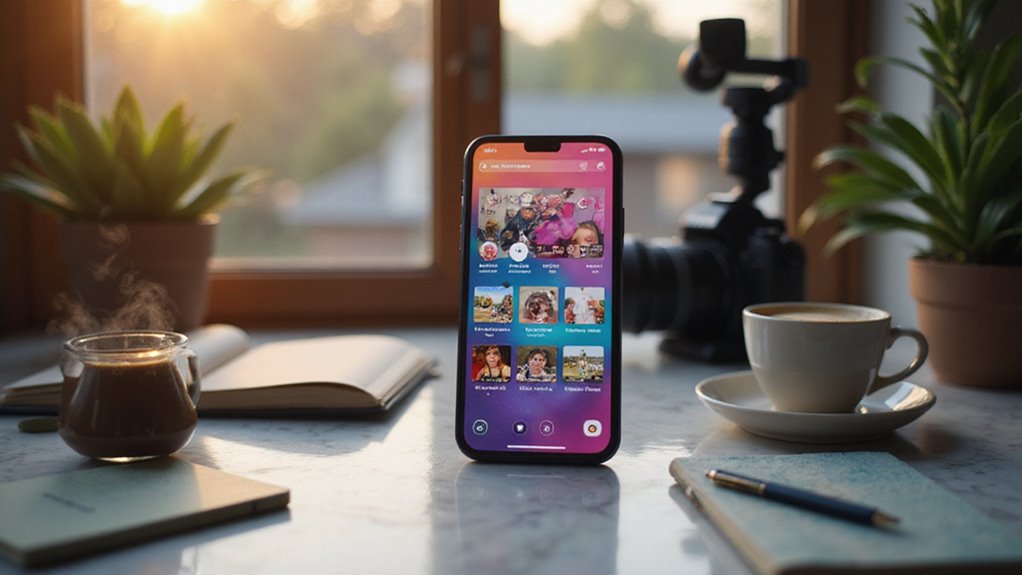7 Essential Tips to Mimic Marketers for Viral Business Content

To create viral business content like professional marketers, focus on short-form videos under 90 seconds, which generate 2.5x higher engagement than long-form content. Leverage AI tools for efficient production while maintaining quality control, and tailor content specifically for each social platform’s unique requirements. Implement data-driven distribution strategies, prioritize visual storytelling, and consistently measure performance metrics to optimize reach. Strategic cross-platform optimization can boost conversion rates by 44%, while authentic storytelling keeps audiences coming back for more.
Leverage Short-Form Video Content for Maximum Impact

While many marketers chase the latest trends, short-form video content has proven itself to be more than just a passing fad. With ad spending projected to hit $100 billion by 2025 and engagement rates 2.5 times higher than long-form content, it’s clear why businesses are racing to master this format. Successful marketers have shown that proven AI tactics can significantly boost video content performance.
The numbers tell a compelling story: 73% of consumers prefer learning about products through short videos, and these bite-sized pieces retain 50% of viewers when kept under 90 seconds. The brain can process visual data 60,000 times faster than text-based information. Platforms like TikTok and Instagram Reels have become powerhouses, with ideal video lengths ranging from 15 to 60 seconds. Who knew such brief content could pack such a punch?
For businesses looking to maximize impact, the formula is straightforward: keep videos concise, mobile-friendly (79% watch on smartphones), and focused on clear messaging. With 95% message retention through video format, it’s no wonder short-form content consistently delivers the highest marketing ROI across all formats.
Harness AI Tools to Scale Content Production
Just like marketers have adopted short-form video, they’re now turning to AI tools to revolutionize content production at scale. With 51% of marketers already leveraging AI assistance and seeing productivity gains equivalent to 47 years, it’s clear these tools are transforming the content landscape. Inspiring content creation depends on developing strategic prompts that align with your objectives.
Today’s savvy content creators use AI across multiple fronts: generating fresh ideas, crafting optimized drafts, and analyzing performance metrics. ChatGPT leads the pack as the most trusted AI companion, chosen by 77.9% of users who appreciate its versatility. With AI-driven algorithms enhancing lead generation by up to 50%, marketers are increasingly relying on artificial intelligence to maximize their content’s reach. Think of AI as your creative co-pilot – it handles the heavy lifting while you maintain creative control.
But here’s the kicker: successful AI implementation requires balance. While these tools can boost efficiency by 66% and maintain consistency across large content volumes, they work best when paired with human oversight. After all, even the smartest AI can’t replicate your unique brand voice and creative intuition.
Focus on Quality Over Quantity in Content Strategy

Every successful content marketer knows that flooding audiences with mediocre content rarely delivers results. The data clearly shows that 83% of marketers now prioritize quality over quantity, recognizing that meaningful engagement drives real business growth.
Think about it – would you rather read one exceptional article that solves your problem or wade through ten superficial posts? Today’s selective digital consumers demand trustworthy, informative content that adds genuine value. When brands deliver high-quality material consistently, they’re rewarded with stronger audience retention and improved brand perception. Research shows that over 60% of B2B businesses incorporate strategic link-building to enhance their content’s authority and reach. Modern marketers are increasingly leveraging AI writing tools to maintain consistent quality while scaling their content production.
The numbers don’t lie: businesses focusing on content quality report better SEO results, with 80% of marketers linking quality-focused strategies to improved search rankings. Plus, through smart human-AI collaboration, maintaining high standards becomes more achievable than ever – 62% of marketers believe AI tools help them consistently deliver premium content while staying true to their brand voice.
Master Social Media Platform-Specific Content
Successful social media marketing requires a tailored approach for each unique platform, with 78% of brands reporting higher engagement when they customize content specifically for different channels. Each platform serves distinct content preferences: TikTok and Instagram Reels favor snappy, music-driven videos, while YouTube excels at in-depth tutorials and series content.
Smart marketers adapt their storytelling techniques to match platform strengths. Want to showcase your brand’s personality? Instagram and Facebook Stories are perfect for behind-the-scenes glimpses. Need to spark conversations? Text-based platforms like Threads and Twitter shine through polls and discussion starters. The key is understanding where your audience hangs out and what makes them tick on each platform. To maximize reach, many brands are now focusing on creative disruption rather than maintaining strict brand consistency across platforms.
Modern content creators also leverage AI tools and automation to maintain consistency while crafting platform-specific content. From Hootsuite for scheduling to AI-powered content suggestions, technology helps deliver the right message on the right platform at the right time. Learning from top marketers’ strategies becomes easier with AI insights that analyze and replicate successful digital marketing approaches.
Invest in Visual Storytelling and Video Marketing

Modern consumers are 10 times more likely to engage with video content than text alone, making visual storytelling an essential cornerstone of effective digital marketing. With 89% of consumers expecting increased video content from brands, businesses must adapt their strategies correspondingly.
Success in visual content requires a multi-faceted approach. Interactive elements like polls, quizzes, and calculators drive engagement, while high-quality video production enhances brand perception across platforms. Think mobile-first, as most video consumption happens on smartphones. Want proof it works? Visual content receives 94% more views than text-only materials. Motion and visuals instantly grab attention, leading to significantly higher social sharing rates.
Smart marketers are taking notice – 85% plan to increase their video marketing budgets by 2025. From case studies to educational content, the possibilities are endless. The key is maintaining authenticity while leveraging various channels, from YouTube to social media stories. Remember to track engagement metrics and conversion rates to justify those investments in compelling visual content.
Build a Data-Driven Content Distribution Plan
Three critical pillars form the foundation of any data-driven content distribution plan: audience insights, platform optimization, and performance tracking. Successful marketers know that businesses conducting thorough audience research are 242% more likely to achieve their goals, making data analysis non-negotiable. According to recent statistics through Ascend2 research data, marketing professionals worldwide are increasingly relying on data-driven strategies to measure their success rates.
Smart distribution starts with segmenting audiences and mapping content to their specific journey stages. By analyzing behavioral patterns and platform metrics, marketers can determine exactly where, when, and how to share content for maximum impact. Think of it as a GPS for content – you wouldn’t start a road trip without mapping the best route first. Leading marketers are leveraging AI tools to automate and enhance their content distribution strategies.
Regular A/B testing keeps the strategy fresh and effective, while consistent measurement of KPIs guarantees ROI stays on track. The key is to remain flexible and responsive to the data. When metrics indicate a shift in audience preferences or platform performance, successful marketers pivot quickly to maintain engagement and maximize results.
Optimize Content for Cross-Platform Engagement
Why do marketers who optimize content across multiple platforms see a 44% boost in conversion rates? The answer lies in strategic content tailoring that meets each platform’s unique demands. Today’s social platforms double as search engines, requiring marketers to adapt their messaging correspondingly. By 2025, 72% of consumers will use at least three platforms to find information, making cross-platform optimization essential.
Think of it like speaking different languages for different audiences. TikTok demands snappy, keyword-rich videos under 60 seconds, while LinkedIn thrives on data-driven thought leadership. Instagram users respond best to visual storytelling through carousel posts and optimized captions, and YouTube viewers expect well-structured content with detailed timestamps. Modern AI copywriting tools are revolutionizing how marketers adapt content across these diverse platforms.
The key to success? Let data guide your approach. With 87% of consumers making purchase decisions after watching videos, it’s clear that visual content rules the digital landscape. Smart marketers leverage AI tools for optimization, track performance metrics religiously, and adapt their strategy based on real-time analytics. When content speaks each platform’s language fluently, engagement naturally follows.